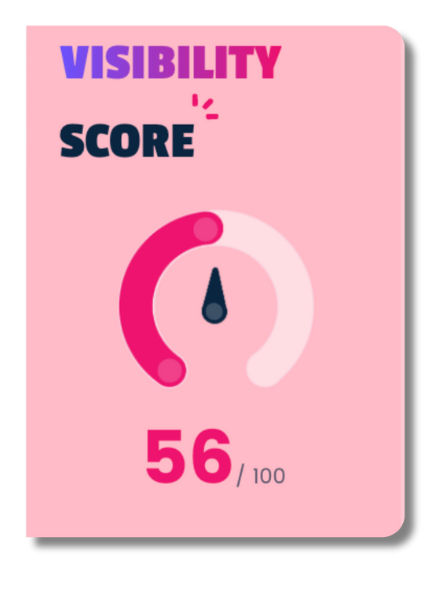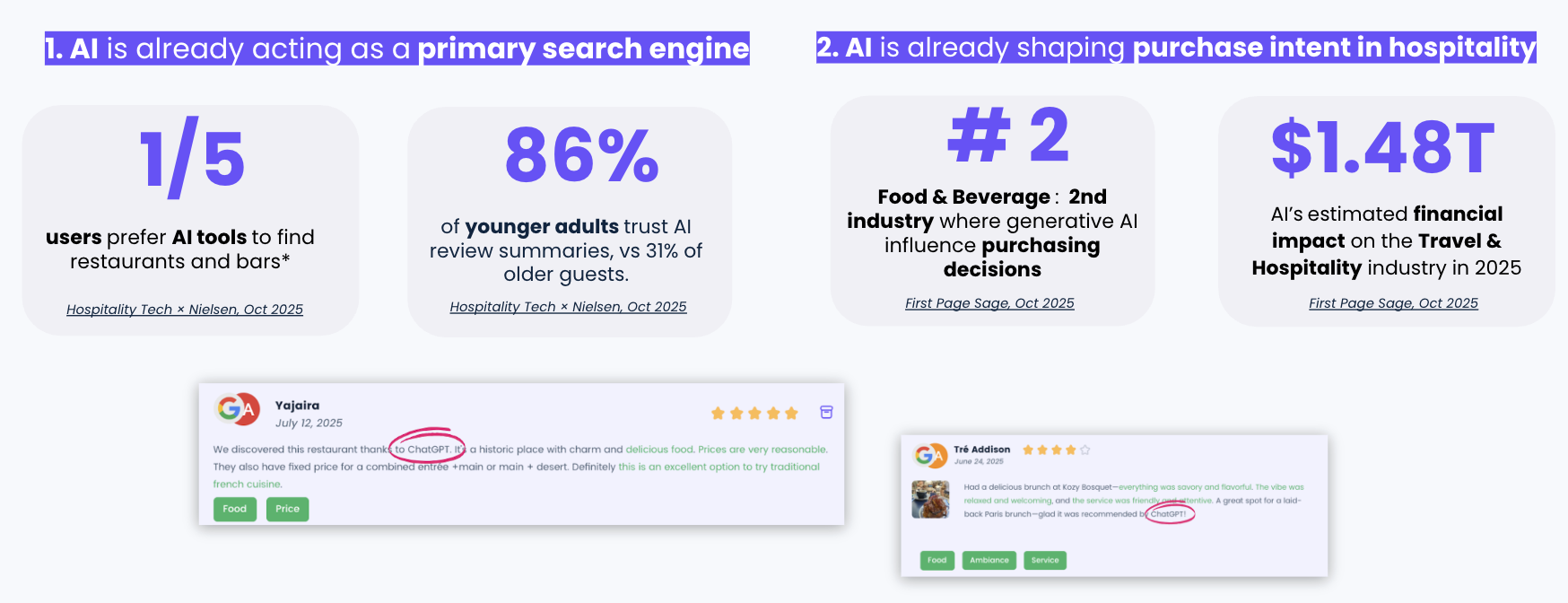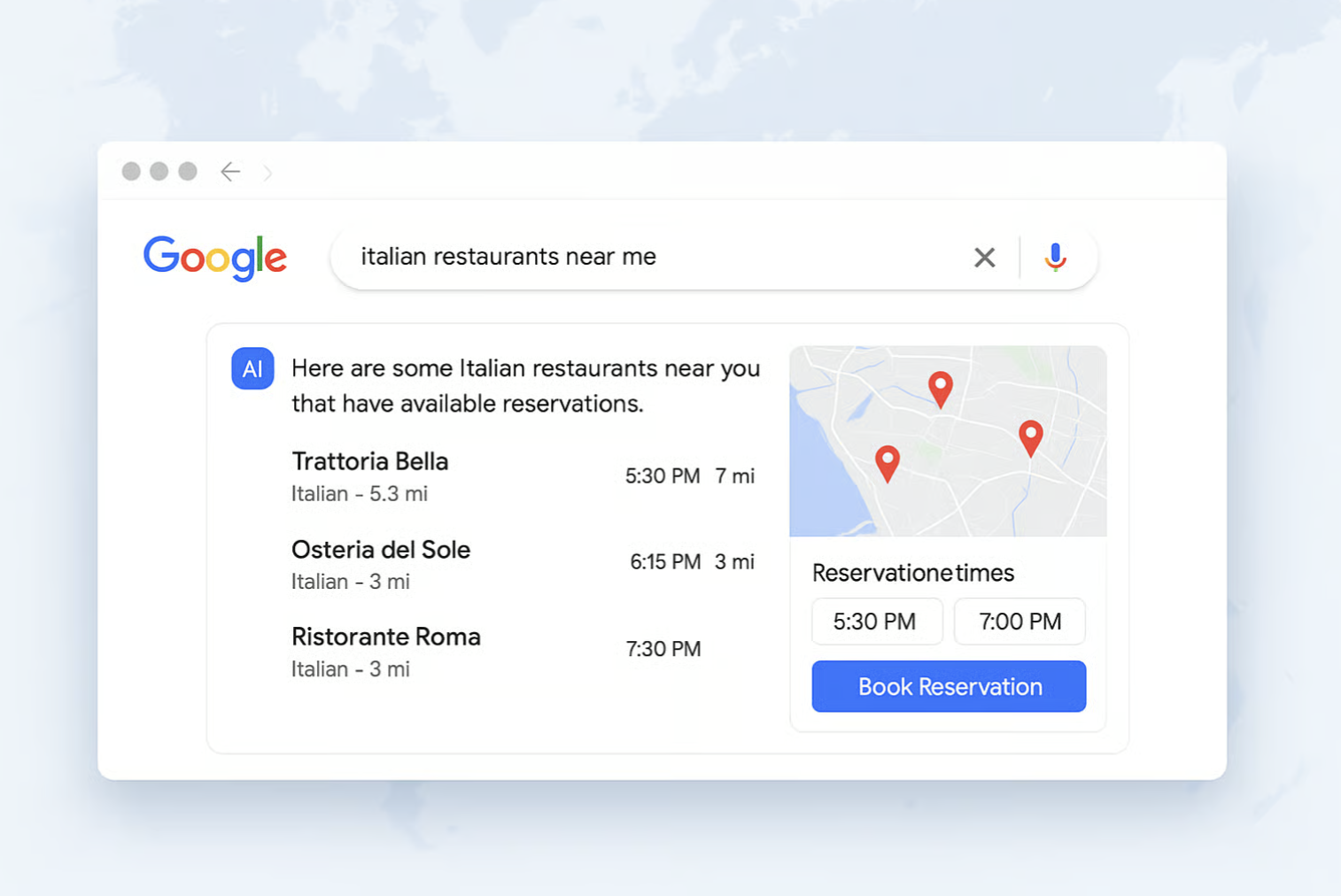
SEO for Restaurant Chains: How to Boost Your Visibility Across Every Location


Find out where you stand, spot what’s holding you back, and get a custom action plan to outrank your competition.
In 2025, 9 out of 10 diners now choose their restaurant on Google and 1 in 5 uses an AI tool to decide where to book.
Welcome to The Search Era: every customer journey starts online, but SEO is evolving.
For current restaurant chains or future franchises, SEO means scaling visibility, consistency, and reputation across dozens (sometimes hundreds ) of locations.
From Google Maps to Instagram, from your website to AI search, the future visibility of any restaurant (from small groups to tops franchises), now depends on how strong your digital ecosystem is.
To make sure all your locations are found nationwide and rank for the right keywords, top management teams need powerful SEO tools and clear methodology.
The good news? In hospitality, digital growth is exponential when your network gets bigger (Source: 2025 Restaurant Groups Benchmark)
The faster you master every layer of SEO, from Local SEO and GEO (GPT Engine Optimization) to Social SEO, the stronger your brand will become in your market.
Let’s break down how hospitality chains like Krispy Kreme, Wingstop, and Bioburger have turned SEO into a growth engine and how your can do the same for all your restaurants.
Not new to the game? Here's the top SEO Trends For Restaurants Chains you should know about to perform in 2026.
🔗 Make sure you subscribe to our webinar "How to Leverage AI for Restaurant Groups in 2026"
1. Why is SEO for Restaurant Chains Different?
There are 2 main reasons to explain why Search Engine Optimization is different groups in hospitality.
More locations = more complexity
Single-location restaurants can rely on one Google Business Profile, one website, one review strategy.
They can also rely on one brand = one SEO strategy.
Whereas, having multi-brands is increasingly difficult (ex: high end groups), so is having to manage one strong brand across multi-locations (ex: franchises).
For restaurant chains, SEO is multi-layered across a network.
Every restaurant is its own digital storefront, each one needs to show up, stand out, and convert.
Usually, the complexity comes from:
- Multiple GBPs to manage and update (Google Business Profile),
- Dozens of directories and apps across the country (from trendy blogs to halal listings)
- Dozens of online reviews per day to monitor, on each directoy,
- Local keywords that differ by city or even neighborhood,
- Inconsistent social content across locations,
- and now… AI tools that recommend restaurants directly.
To win locally, you need to think globally by structuring your digital presence as one connected ecosystem. This is also how algorithms and LLMs think: ecosystems are like a human network.
They send green flags to bots, "this brand is active and legit". (Source: "How To Leverage AI for Growth" - Webinar for Groups in Hospitality)
The AI Revolution: New Rules
With AI Overview on Google and most AI new tools, AI trends are reshaping the way restaurant chains need to work on their online visibility.

AI-powered discovery is already here.
1 in 5 U.S. consumers, including 45% of those aged 35–44, turn to AI tools like ChatGPT for venue discovery (Source: Hospitality Tech).
Moreover, tomorrow’s AI discovery might consist in one only platform instead of a list fo website.
This is what we see with AI Overview, for instance.
Good SEO will rely less on clics, rankings in a list of websites, etc.
Finally, AI tools for restaurants, like ChatGPT or Perplexity, don’t respond to the same criteria as Google to offer a curated list of restaurants.

LLMS (Large Language Models) have different mechanisms than traditional search engines like Google.
They rely more on signals like: structured data, UGC (User Generated Content like reviews or blogs), local pages, etc.
We'll talk further about AI visibility in the step 6 of this article.
For now, let's start with SEO for restaurant chains: what should be your next step?
🔗 Or read our top article: Restaurants & GEO Optimization : the new SEO
2. What SEO Keywords Should Restaurant Chains Use
SEO Keywords and queries are the foundation of visibility.
They determine how, when, and where your restaurant appears — on Google, Google Maps, and even in AI-generated results.
For restaurant groups, a keyword strategy must be hyperlocal and multi-layered.
Every location should have a mix of shared brand keywords and specific local ones that reflect its market, menu, and audience.
Why it matters (for Google and AI):
- 68 % of all restaurant-related searches include a location or intent modifier (“near me,” “in Brooklyn,” “open now,” etc.).
- Gemini and ChatGPT now favor brands that include clear entity + location + attributes in their structured content.
- The right keywords also improve AI retrievability by creating semantic connections between your website, GBPs, and Store Locator.

How to build your keyword strategy for multi-locations:
- Start with your brand identity.
Define the 5–10 keywords that represent your offer and category (e.g. vegan burgers, poke bowl, brunch café, Italian trattoria).
➜ These will serve as your brand-level keywords (the DNA of your group). - Add location modifiers.
Combine each core keyword with its city or neighborhood (e.g. vegan burgers Miami, brunch SoHo, poke bowls Chicago).
➜ These form your local keywords, unique to each restaurant. - Include experiential and attribute-based terms.
These capture how people actually search: “kid-friendly,” “with terrace,” “pet-friendly,” “fast casual,” “gluten-free.”
Google’s algorithm increasingly ranks by experience and intent — not just dish names. - Use keywords consistently across your ecosystem.
Your GBPs, local pages, and Instagram captions should share the same semantic field.
➜ This coherence strengthens both SEO and GEO (AI retrievability). - Update and monitor monthly.
Use tools like Google Search Console, SEMrush, or Malou’s Store Locator to track each location’s top queries, impressions, and quick wins (positions 10–20).
💡 Pro tip: Don’t chase volume, chase intent. For example, “restaurant New York” has millions of searches, but “Italian restaurant SoHo with terrace” is where bookings actually happen. It's all about conversion.
3. How to Create a Restaurant SEO Strategy: 6 Steps And A 360° Framework
You need to make sure all your marketing tools are connected, centralize and share data to make sure you are basing your decisions on top analytics.
Each layer reinforces the others, from local directories to AI visibility.
Here’s the full hierarchy and steps👇
Step 1 — Get Listed on All Platforms & Directories
Your first step is ensuring every location appears consistently across high-authority directories: you can explore them in The 12 Best Platforms to List Your Restaurants. Google Business Profile, Yelp, Apple Maps, TripAdvisor, Facebook, Resy, OpenTable, Uber Eats, and more.
This top SEO technique for groups is called "presence management".
📈 Groups that maintain consistent listings across 60+ platforms see up to +74% faster growth in visibility and bookings (Malou Group Ebook, 2025).
See it like this: every directory is a “trust signal” to Google, proving your restaurants are active, local, and legitimate.
The more consistent and complete your listings, the stronger your authority.
Make sure you have a top marketing solution to refresh your key info (hours, menus, etc.) on all locations at once, all year long.
Some directories may even seem silly (like the White Pages), but as long as they are connected to your market and core business (ai, food) they are allowing you to become n°1 on a lot of keywords and queries, including local.
Think of it as a giant spiderweb: they strengthen your network of relevance.
Step 2 — Optimize All Location's Google Business Profiles (GBP)
If your restaurant group manages several locations, remember this golden rule:
1 location = 1 Google Business Profile = 1 local page on your website.
This structure is now officially recommended by Google.
It allows your brand to appear in local search results for every city or neighborhood where you operate, while building consistent authority across your entire network.
When users search for “best sushi in SoHo” or “family-friendly brunch Austin,” Google relies on these individual GBPs to surface the most relevant nearby results.
And so do LLMs: AI models rely heavily on Human Generated Content (HGC), such as reviews, quotes, and attributes, to decide which restaurants to recommend.
In other words, your GBP is now both a discovery tool for humans and a data layer for AI.
What used to be the famous Local 3-Pack on Google Maps is now increasingly powered by Gemini and AI Overviews.

But for now, Google Search remains the #1 entry point for restaurant discovery:
- 76 % of diners search on Google before choosing where to eat (BrightLocal).
- 59 % of all clicks go to the Top 3 results on Google Maps.
In a nutshell, your locations’ GBPs are the first layer of data AI tools and Google's algorithm read to understand who you are, where you are, and why you matter.
How to optimize all your restaurants's Google Business Profile pages:
- Create one GBP per location.
Each restaurant must have its own profile with localized content, keywords, and visuals that reflect its specific neighborhood and audience. - Link each GBP to its dedicated local page
(for example:yourbrand.com/locations/austin).
➜ This is called a slug. It strengthens both your Google ranking and your AI retrievability by helping algorithms connect your website and your GBPs.
(We’ll dive deeper into this when we discuss your Store Locator and local SEO pages). - Complete every field, really, all of them.
Google rewards full profiles: attributes (terrace, vegan options, family-friendly), menus, photos, booking links, descriptions, and opening hours.
This can make the difference for a niche query, like a tourist looking for “free Wi-Fi” or someone searching “brunch with terrace.” - Keep content fresh.
Post weekly through Google Posts for specials, events, team stories, or menu updates.
The ideal rhythm: 2 to 3 posts per week, per location. - Reply to every all review, within 72h.
This is essential, not only for e-reputation but for SEO and GEO (AI retrievability).
Reply within 72 hours whenever possible, using a consistent and human tone.
In 2026, brand mentions are highly rewarded by both AI and SEO, for example, “Krispy Kreme has the best glazed donuts, hands down.”
AI favors unique, differentiating, and human content. - Align visuals and voice across platforms.
Use the same images, color palette, and tone on your GBPs, local pages, and social media, especially Instagram, which is now indexed by Google.
(See our full article How Optimizing Instagram Boosts Your SEO).
💡 Pro tip: Centralize all GBP management in one place, even better, a top marketing App. Then use a Store Locator to refresh all your locations' data (hours, menus, photos) across every listing, in a one single click.
🔗 Here's how a Store Locator works for restaurant chains'SEO and AI visibility.
Step 3 — Manage Reviews Like a Growth Channel
Yes, your online reviews are key to online reputation. They also direct ranking factor in both Google and AI-driven search results.
Reviews act as signals of trust for search engines. They tell Google and LLMs that your restaurants are active, loved, and worth recommending.
Why it matters (both for SEO and clients):
- 88 % of diners trust online reviews as much as personal recommendations (Trustpilot, 2025).
- +1 ★ rating = +11 % revenue on average (Harvard Business Review).
- Gemini and ChatGPT increasingly quote user reviews and public comments as proof of quality.
If you’re managing 10 or 100 locations, a solid review management process (e-reputation) becomes critical. Not just for SEO, but for brand control, customer retention, and AI visibility.
How to manage reviews efficiently (multi-location checklist)
- Centralize all reviews in one dashboard.
Use a platform that connects your GBPs, Facebook, Yelp, and delivery apps like Malou's App with semantic analysis.
➜ This gives you a clear overview of brand sentiment per location. - Respond to every review — fast.
Within 72 hours for 1–4 ★ reviews, 24 hours for 1 ★.
Acknowledging feedback shows both customers and algorithms that your brand is responsive and human. - Use the right tone.
Always thank, contextualize briefly, and reaffirm your brand values.
Example:
“Hi Jane, we’re sorry about your wait time — our team was handling a big event. We’ll make sure you’re served faster next time.”
- Spot recurring themes.
Negative patterns (slow service, cold food, unclear signage) are operational gold.
Share insights with area managers to fix what hurts both your ranking and your revenue. - Highlight your best reviews in your content.
Add 5-★ reviews to your local pages, Google Posts, or Instagram stories.
Mentions combining brand + location (“Krispy Kreme Austin”) strengthen both SEO and AI retrievability.
💡 Pro tips for groups: make sure you 1) incentivize every location’s staff to contribute to the network’s overall rating.
2) Provide brand guidelines — with tone examples, response templates, and do/don’t examples (especially for franchises).
3) Create internal “review champions.” Each manager answers reviews weekly and tracks their store’s average rating.
4) Share monthly wins and best practices to create healthy competition and a growth-minded culture.
Groups that reply to 100 % of reviews gain up to +0.4 ★ on Google within 6 months (Malou Group Study, 2025).
Step 4 — Build a Store Locator and Local Pages (Your Growth Engine)
One website isn’t enough for a restaurant chain SEO strategy.
Each location needs its own optimized local page, linked to its GBP, linked to analytics you can track.
A Store Locator automatically generates pages for each restaurant, complete with schema, reviews, and local keywords.
It’s your scalable SEO engine as:
- Local pages capture “near me” searches.
- They help AI understand your brand geography (structured data)
- They improve your site’s SEO, UX, and conversions.
Example:
- Wingstop reached Top 3 rankings on 6/10 keywords after launching its Store Locator.
- Bioburger saw +48 % impressions on Google Maps and +30 % “Call” actions.
💡 Pro tip: Use a tool with structured data and interlink like Malou's Store Locator to reinforce crawlability and readability.
Step 5 — Leverage Instagram for SEO (Social SEO)
Since July 2025, Google started indexing public Instagram content from professional accounts.
Which means your Instagram profile is now part of your SEO: any public post from one of your restaurant can appear on a Search Engine like Google.
When users search “best rooftop brunch in Austin,” your Reel or carousel can appear in the results.
What this means for restaurant groups:
- Your best posts can now rank for local keywords (especially the most liked ones)
- Old content gets a second life.
- Social media and SEO finally work toward the same goal: discoverability.
💡 Pro tip: Use Malou's Store Locator to make sure your Instagram feed is embed on your local pages — this keeps content fresh; helps your site appear in visual-rich searches and is also good for User Experience (will act as a visual online menu).
Step 6 — Prepare for GEO (GPT Engine Optimization)
SEO gets you ranked on Google. GEO gets your brand retrieved inside AI results. Both work together.
GEO or AIO is actually "part" of SEO, and will continue to be.
As AI tools like ChatGPT, Gemini, and Perplexity become restaurant recommendation engines, you need to ensure your brand’s data is structured, fresh, and cited.
How to prepare:
- Maintain consistent data across GBPs, Store Locator, and social.
- Use schema markup for clarity.
- Encourage external mentions (press, blogs, Reddit).
- Keep updating — AI favors freshness.
- Strengthen your authority with genuine, human-generated content (HGC).
🔗 Again, don't miss our next Webinar on AI and SEO of Restaurant Chains.

Final Takeaways
Here's the final checklist:
✅ SEO for restaurant chains = ecosystem, not tactic
✅ 1 location = 1 GBP + 1 local page
✅ Reviews + Local pages = ranking power
✅ Social content = SEO content
✅ GEO = your next competitive advantage
Ready to Scale Your SEO?
Discover how visible your restaurants really are! Run a free Malou session or call us directly at +1 (929) 494 52 10
We put The double bites to satisfy you
Increase your visibility on Google and social networks with Malou.




.jpg)
.jpg)